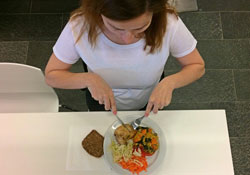Toxoplasmosis: greater awareness needed

WHO
During a routine visit to the doctor during her pregnancy, Dorte Remmer saw a request for women to participate in a scientific study. The study was asking for mothers to allow researchers to screen their newborn babies for toxoplasmosis. As a medical professional, she wanted to contribute to her field, but it was a big shock when her one-day-old baby tested positive for Toxoplasma gondii.
Across the WHO European Region, the risk factors for infection of Toxoplasma gondii, particularly for pregnant women, and the consequences for infected babies or immunocompromised adults, are largely unrecognized.
What is Toxoplasmosis?
Toxoplasmosis is caused by the protozoan parasite Toxoplasma gondii, and affects more than 2 million people every year in the European Region.
Toxoplasma can be acquired trans-placentally (mother to baby), through contact with infected soil or water, ingestion of contaminated food, or in very rare cases through blood/organ donation. It is assumed that half the cases come from eating contaminated food, such as inadequately cooked animal meat, or raw fruits and vegetables. Infection can also occur through contact with cat faeces in the environment, but cats only shed oocysts for a few weeks of their life, usually when kittens. Cats play an important role in the life cycle of the parasite, but they are not the main vehicle of infection.
It is estimated that 95% of people with healthy immune systems will not develop clinical symptoms if infected with Toxoplasma, or they might notice mild influenza-like symptoms that quickly pass.
For this reason, many people do not know when they become infected. In immunocompromised individuals, toxoplasmosis can manifest with more serious symptoms in the eyes, brain and other organs, such as inflammation of the eye that may result in vision loss.
Franziska, interviewed for this story, discovered she had toxoplasmosis a few months into her pregnancy. While she recalls having a mild cold, she will never know how she acquired the infection that led to extensive medical tests and months of treatment.
Surveillance of toxoplasmosis varies considerably between countries, posing a challenge in estimating the burden and outcomes of this disease.
Toxoplasmosis during pregnancy
If women become infected with Toxoplasma during or just before becoming pregnant, the protozoa can be transmitted to the fetus. While not all babies infected in the womb will develop clinical signs of the disease, the infection can lead to miscarriage, stillbirth, or babies may be born with brain abnormalities or partial to complete vision loss. Up to 85% of children infected in utero will develop a decreased quality of vision, and while most symptoms are revealed within the first year of life, the disease can continue to develop until adolescence.
Serologic testing can identify if a pregnant woman has ever been infected with Toxoplasma. If a woman has been infected in the past, there is very little risk of transmission to the fetus. If she has not been previously infected, there is a risk of contracting the disease during pregnancy, which she could then pass to her baby.
When a pregnant woman tests positive for a recent or current infection, she can choose to test the fetus, either through placental blood or amniotic fluid. However, screening is not routine or required in most countries of the European Region. Recommendations are based on a cost–benefit analysis of the prevalence and consequences of the disease in the country and associated risks of screening.
Food safety
To prevent foodborne toxoplasmosis, one should follow the WHO 5 Keys to Safer Food. Effective hygiene including hand-washing and the use of clean water in food production and preparation is critical. Pregnant women should avoid undercooked meat. Fruits and vegetables should be thoroughly washed with clean water.
First-hand experiences
WHO has spoken to people who work with, and have first-hand experience of this common, but largely unknown disease, in order to raise awareness, explain the risks to pregnant women and their babies, and promote prevention.



